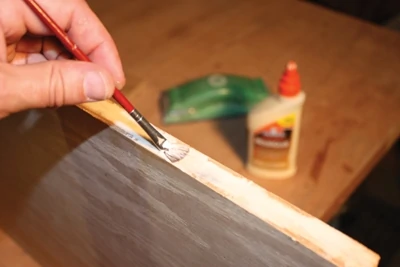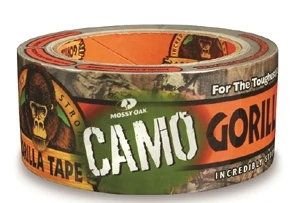By Michael Springer
A Guide to Glues and Adhesives used in Home Improvement.
There is a dizzying array of glue and adhesive products in the stores that promise to stick together whatever it is you are working on—far too many to keep track of. The goal of this article is to help you better understand both the properties and uses for the most common categories of adhesives used around the home jobsite.
Glue or Adhesive?
Technically, glue falls within the broader definition of adhesives, even though it is much more common to use the term gluing rather than adhering. Some traditionalists say that glue refers to formulations made from natural animal or plant materials while adhesives contain only synthetic chemical ingredients, but that line blurred long ago. With the exception of true hide glues, glue products made for the consumer market contain nearly all manmade ingredients. While practically interchangeable in current parlance, adhesive is the term used by industry, and glue is the more casual term that has “stuck” with craftsmen and consumers.
Curing Vs. Drying
Adhesives and glues change physically and chemically when going from a fluid state in the container to a solidified state after application. This is the process of curing. When curing happens by the evaporation of water or another solvent, this process is typically called drying. Adhesives that cure by drying can often be dissolved in their original solvent. This is the case for most water-based glues and is the reason they are not water-proof.
Other curing processes involve a chemical reaction, whether from absorbing moisture in the air, or by catalyzing one adhesive ingredient with another. The resulting mixtures—once fully cured—are typically more resistant to solvents (including water).
Preparing Surfaces
Besides the bonding surfaces being clean and free of and oil or grease, follow the specific instructions included with the adhesive for best results. For example, some exotic oily woods require a cleaning with specific chemical solvents to enhance bonding. And despite the fact that most glues adhere to the substrate on a molecular level, some adhesives recommend scuffing the materials being glued with coarse sandpaper to increase the bonding surface area or to add a degree of mechanical bonding.
Open Time
Follow the instructions for open time (or working time) and remember that higher temperatures mean shorter open times. Spread the glue and join the surfaces before the adhesives set up, and clamp as soon as possible afterward. For best results, leave the work undisturbed for several hours. Even though some glues only require 30 minutes of clamping time, they will not reach full bond strength for 24 hours.
Buy Fresh
Look at the dates on any adhesives you buy to find the freshest product possible.
Be aware of the shelf life of the product. Don’t stock up and plan on storing glues for years; many should be used within one year of opening. Store adhesives in a cool place away from direct sunlight.
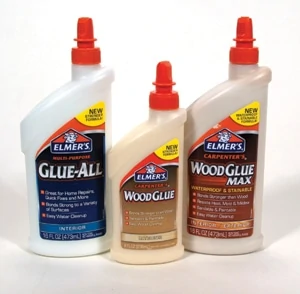
PVA WOOD GLUES
Yellow or white water-based wood glues are classified as PVA glues because polyvinyl acetate is the active ingredient.
The yellow variety—generally called carpenter’s glue, and previously labeled as aliphatic resin glue—is the most commonly used glue for wood-to-wood bonds. Besides the yellow dye intended to blend with natural wood color, this PVA is modified to set up faster, dry harder, and resist heat better than standard white PVAs. These last two properties allow carpenter’s glue to be sanded without gumming up the sandpaper. The benefits of standard white PVA are its longer open time and its ability to dry clear. Both PVAs provide bonds stronger than the wood itself, but the customized properties of carpenter’s glue make it the better choice for most interior wood gluing.
For wood exposed to weather or in other wet locations, exterior carpenter’s glues are the PVAs to use. There are two different ratings for exterior glues as classified by the American National Standards Institute (ANSI). Type II glues are water resistant and can handle outdoor wetting and drying cycles. Some brands call this water resistance rating “weather proof.” Type I glues are waterproof so the glue bonds can be constantly saturated but not immersed under water.
Tips:
- A “rubbed” joint is a time-honored method to get carpenter’s glue to tack up quickly and firmly without clamping. Literally rubbing the joint back and forth about an inch for a few seconds will spread the glue and develop suction that holds the wood tightly together.
- Since these glues shrink while curing (as the water in them dries out), it is best to “size” thirsty glue joints such as end grain. Sizing consists merely of coating the wood with glue and letting it dry before recoating the joint for final glue-up. You may need to sand the dried glue flat before recoating for the tightest fit. While an absolute necessity for picture frames, this trick is also guaranteed to make your baseboard and window and door casing miter joints much stronger.
- Despite what the instructions say, don’t wipe excess glue off with a damp rag if you are going to stain or clear-finish the wood surrounding the glue joint.
The thinned glue smears into the pores of the wood and blocks the even absorption of finishes. Instead, it’s best to peel the glue off with a putty knife when it sets up like soft plastic. Failing that, scrape or sand the glue off carefully when dried.

Polyurethane Glue
Besides being excellent for wood, versatile polyurethane glue adheres many nonporuous materials that PVA glues cannot. Polyurethanes react with moisture in the air to cure to a water-proof bond and are suitable for interior and exterior use. To speed up cure times, manufacturers recommend dampening one side of the glue joint. Since the glue expands three or more times its original volume, either too much glue or too much moisture will create excessive foaming as the mixture reacts while curing. When dry, the foam is easy to scrape off, but because the expanded foam is weak, polyurethane glues have no gap-filling strength. Joints must be tight to cure strong.
Since these glues expand when curing, sizing is not required for end grain. However, because this expansion can introduce movement to the glue joint, clamping is advised whenever using polyurethane glue.
Tips
- Apply this glue sparingly. Besides creating a mess, any foam-out is wasted glue.
- Wear disposable gloves and a shop apron when applying. This ultra-sticky glue has to be scrubbed off the skin and it will ruin clothing and work gloves.
- Don’t stock up. This glue has a relatively short shelf life and once it starts to harden in the bottle, it goes fast—there is no way to solvent-thin polyurethanes.
- Keep the lid on. As long as the glue looks like glue and spreads like glue you can use it, but you may have to cut open the bottle to get it out if it has skinned over. Don’t ask me how I know…
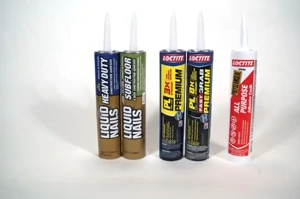
Construction Adhesives, Adhesive Caulk
These thick-bodied adhesives provide strong structural bonds in common building materials. They are not necessarily stronger than wood glues in similar bonds, but unlike wood glues, construction adhesives are approved for structural use and display their various testing approvals on the label. This is important for building-code compliance.
Besides making them more economical per volume, the elastic solids that provide extra body to these adhesives also provides for the flexible bonds needed in house components. For example, an adhesive connecting sub-floors to joists requires enough give so the bond will not shear from the substrate as the floor assembly flexes under live loads.
There are three main types of construction adhesives in common use: traditional solvent-based, water-based latex, and polyurethane adhesives. The latex is the newest formulation, growing in popularity as more states and municipalities move toward requiring Low-VOC (less toxic) or No-VOC products to be used in home construction. This is also leading the trend of reduced VOC solvent-based adhesives. Polyurethanes are already classified as Low-VOC.
These adhesives are sold in 10 ounce caulk-gun tubes and 28 ounce tubes (formerly known as “quart” tubes).
Similar to construction adhesive but for non-structural uses, adhesive caulk will work on many common building materials but is best for sticking up a few replacement tiles or attaching a ceramic tile backsplash above a counter. Another great use is to caulk a toilet to the floor. It keeps it from rocking and shifting, regardless of what condition the closet bolts are in.
Tips:
- For subfloor use, make sure the adhesive has the specific subfloor approval.
- Use polyurethane construction adhesive for bonding small areas of granite tiles or trim to walls or countertops without having to mix a batch of mortar.
- The super strength and multi-material compatibility of polyurethane construction adhesive provide the perfect solution for gluing structural wood to the bottom of steel I-beams for framing out a basement ceiling. This is the use that opened my eyes to the versatility of this product almost 20 years ago.
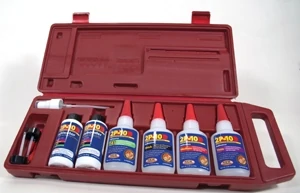
Cyanoacrylate (CA) “Instant” Glue
Widely called super glue (since that name is not copyright protected), CA glues are known for their ultra fast bonds on a wide variety of materials. Standard CA glues are water thin and best used for tight fitting, nonporous surfaces, but thick bodied and gel formulations are now available, which work better for wood repairs and even offer some gap filling strength. Spray activators for CA glues greatly accelerate bonding time and ensure full cures faster.
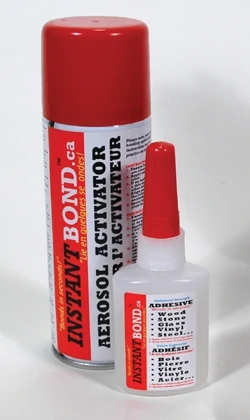
These adhesives are sold in a variety of sizes, but buy only what you will use within one year. Despite the stated shelf life, once opened, exposure to moisture in the air hastens curing in the bottle. Store in a cool place. Some brands recommend storing in the refrigerator or even the freezer, but remember, the greater the temperature differential between the glue and room temperature, the more likely water in the air will condense on contact and moisture-cure the glue at the tip, or even in the bottle. Keeping the lid on the bottle as much as possible will help in either case.
Tips
- CA glue is the best thing for treating dry, split fingertips and takes the pain away faster than any lotion. By sealing the skin on the outside, splits moisturize and heal from the inside.
- Wood turners and carvers use CAs for ultra quick repairs of chips or cracks on a work in progress with virtually no down-time.

Epoxies
Epoxies are adhesives that chemically cure when two separate components are mixed. Typically the resin and hardener (or catalyst) components are mixed 1:1, whether proportioned by eye out of squeeze tubes, or automatically by squeezing side-by-side syringes. Since they cure by way of a chemical reaction, epoxies make very tough bonds and are impervious to being softened or dissolved with most solvents.
The high strength of their bonds and great gap filling characteristics make epoxies suited for gluing and patching the widest range of materials, including most metals. Epoxies cure to a durable solid form, and those with solid fillers can be drilled, filed, sanded, and cut to shape along with the material they are adhered to.
Tips
- It’s best to mix the two parts together on a non-porous surface so the epoxy won’t wick away and become dry.
- For bonds under extreme pressure such as bent wood laminations, it is important to use an adhesive with low creep. Epoxies are the best for this application.
SIDE NOTE
Cleanup & Storage
Gorilla Tape is Gorilla Glue Inc.’s superior alternative to traditional duct tape. It’s a heavy-duty, double-thick tape manufactured with twice the adhesive of standard duct tape. Gorilla Tape sticks to rough, uneven surfaces like wood, stone, stucco, plaster and brick. The tape has a heavy-duty cloth backing with a tough, outer shell that resists moisture, UV rays and temperature cycles. Plus, Gorilla Tape now comes in Mossy Oak camouflage, perfect for hunting, fishing, camping and all sorts of outdoor activities. Learn more at www.gorillatough.com.

Liquid Nails Acoustical Sound Sealant (AS-825) is an elastic, durable sealant designed to reduce sound transmission in all types of wall systems. Available alongside Liquid Nails Drywall Adhesive (DWP-24) at building material distributors nationwide, Acoustical Sound Sealant remains flexible, has a very low odor, is VOC-compliant and can be cleaned with water. The product helps reduce drafts and deaden sound, tested per ASTM E 90 for acoustical properties and per ASTM E 84 for flame spread and smoke generation. Acoustical Sound Sealant is recommended for use on wood, drywall, cement board, OSB, steel studs, concrete, masonry and more. Learn more at www.liquidnails.com.
Other Glue and Adhesive Articles


